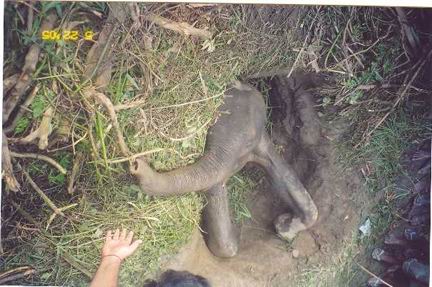Human Elephant Conflict - An environmental Tragedy –Part II
-Ankur Chaturvedi
Elephants are big, and they are nomads. The huge physical structure of the elephant demands a massive diet, up to 250 kgs daily plus huge quantities of water, which essentially dictates that it cannot remain stationery in one patch of forest; else it will
degrade the forest, and eat itself out of its home. Elephants, therefore, follow ancient migratory routes, generally 1-3 km long corridors, which link elephant habitats.
Moreover, the forests have become too fragmented even to support the 300-odd elephants, thus the elephants are compelled to move through tea gardens, villages and agricultural fields killing more than 60 persons annually. In contrast to the figures for north
Bengal , only 30 to 40 deaths are caused by human-elephant conflict in southern India , even though the elephant population is more than 20 times the Wild elephant population of North Bengal .
Elephant migration is dictated by ancient instincts; only the forest it knew is now tea gardens. Traumatized and starved, it marauders crops that come in its way, occasionally killing angry, helpless people protecting their homes and livelihood.
Another major lure for the elephants is the liquor. At times, elephants only come to the labour lines to have their fill of hadia , the rice beer brewed extensively by the tribal population of the Tea gardens in the area. A tipsy elephant is no means better
off than his human counterpart. The loss to life and property caused by these few dipsomaniac rogues is much more than that caused by elephants in herds.
The mobile squads of the forest department assigned to the task of alleviating the HEC are under equipped, under staffed and untrained. One thing that they don't lack is courage and conviction. It is not easy to herd wild elephants from inhabited areas with
a risk of attacks from not only the wild animals but also the bereaved human population. Unfortunately, despite their commendable dedication, the approach of the squad is not proactive. Their activities are confined to chasing away the wild herds as and when
they venture out of the forests. In most cases they end up driving them from one human habitation to another till the elephants themselves choose the return to the forests at daybreak. Even the means used by them are no lees cruel. The sight of mammoth bodies
riddled with splinter from 12 bore gunshots is horrendous.
A well-trained volunteer group in every Village/Tea Garden can minimize the detrimental effects of HEC. The volunteer group at Dam Dim Tea Estate has been very effective. The loss of life and property in this particular estate has been minimized despite
its location on a migration corridor.
 Another major contributor to HEC is the lack of socio-economic development in the area. The virtues of conservation cannot be explained to an empty stomach. A large number of people enter the forests illegally to collect firewood, Graze cattle and at
times even hunt, thus denuding the forests. Allure of these shortcuts to economic prosperity gets amplified with the lack of other avenues for progress. The organisations involved with socio-economic development schemes can be effective conduits for spreading
environmental awareness.
Another major contributor to HEC is the lack of socio-economic development in the area. The virtues of conservation cannot be explained to an empty stomach. A large number of people enter the forests illegally to collect firewood, Graze cattle and at
times even hunt, thus denuding the forests. Allure of these shortcuts to economic prosperity gets amplified with the lack of other avenues for progress. The organisations involved with socio-economic development schemes can be effective conduits for spreading
environmental awareness.
The long-term solution lies in providing a corridor for the Elephants to migrate between habitats. The option of using the vast tracts under Tea Plantations remains untapped. Elephants do not eat tea leaves and also avoid walking through the bushes, normally
walking across the footpaths. They do cause extensive damage to shade trees which can easily be avoided by planting some specific species in these corridors. I believe a study was carried out to map the corridor, but like so many other conservation schemes
in our country, has not been a priority for further progress.
A few days back while driving along the highway across the Gorumara Wild life Sanctuary, a villager waved to stop me. My inquisitive glance was met by shouts ofMaha Kaal , Maha Kaal. As I shifted my gaze to the road ahead, I saw a huge Elephant
standing right next to the road. An elephant on the road was an ordinary sight in these parts, what intrigued me was “Maha Kaal”. The villagers were referring to the Elephant as
Maha Kaal. As per Hindu mythology,Maha Kal is the lord of Death. In view of the wide spread destruction cased by the wild herds, it was not difficult for me to rationalise this new label. The burning issue is- Can we allow this transformation
ofGanesh into Maha Kaal ?
Ankur Chaturvedi
Dam Dim Tea Estate
Tata Tea Limited PO- Dam Dim
Jalpaiguri WB- 735209
ankur.chaturvedi@sify.com
Update in 2018
Watch our short film on human elephant conflict at the link
https://youtu.be/Z08hNz-Puok